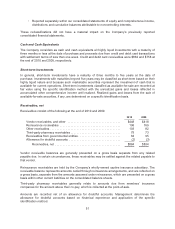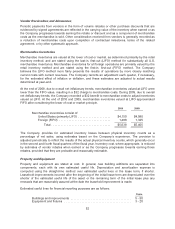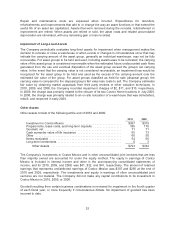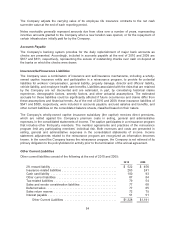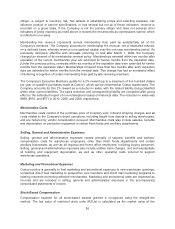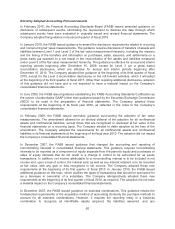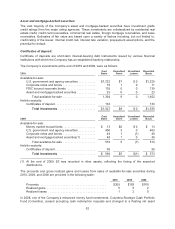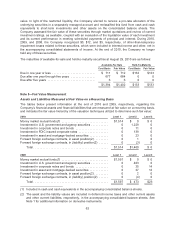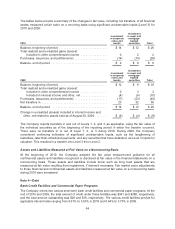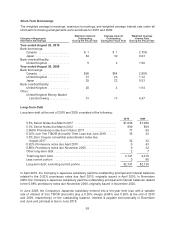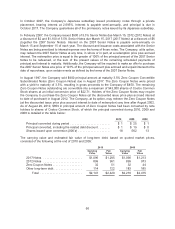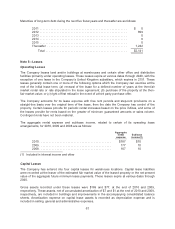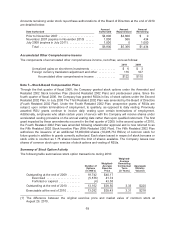Costco 2010 Annual Report Download - page 61
Download and view the complete annual report
Please find page 61 of the 2010 Costco annual report below. You can navigate through the pages in the report by either clicking on the pages listed below, or by using the keyword search tool below to find specific information within the annual report.Other-Than-Temporary Impairment
The Company periodically evaluates unrealized losses in its investment securities for other-than-
temporary impairment using both qualitative and quantitative criteria. In the event a security is deemed
to be other-than-temporarily impaired, the Company recognizes the credit loss component in interest
income and other, net in the consolidated financial statements. The Company generally only invests in
debt securities.
Income Taxes
Effective September 3, 2007, the Company adopted authoritative guidance related to uncertain tax
positions, which clarified the accounting for uncertainty in income taxes recognized in financial
statements. This guidance prescribes a recognition threshold and measurement attribute for the
financial statement recognition and measurement of a tax position taken or expected to be taken in a
tax return and also provides guidance on derecognition, classification, interest and penalties,
accounting in interim periods, disclosure, and transition. The cumulative impact of the initial adoption of
this guidance was to decrease the beginning balance of retained earnings and to increase the
Company’s liability for uncertain tax positions and related interest by a corresponding amount.
The Company accounts for income taxes using the asset and liability method. Under the asset and
liability method, deferred tax assets and liabilities are recognized for the future tax consequences
attributed to differences between the financial statement carrying amounts of existing assets and
liabilities and their respective tax bases and tax credits and loss carry-forwards. Deferred tax assets
and liabilities are measured using enacted tax rates expected to apply to taxable income in the years in
which those temporary differences and carry-forwards are expected to be recovered or settled. The
effect on deferred tax assets and liabilities of a change in tax rates is recognized in income in the
period that includes the enactment date. A valuation allowance is established when necessary to
reduce deferred tax assets to amounts expected to be realized.
The determination of the Company’s provision for income taxes requires significant judgment, the use
of estimates, and the interpretation and application of complex tax laws. Significant judgment is
required in assessing the timing and amounts of deductible and taxable items and the probability of
sustaining uncertain tax positions. The benefits of uncertain tax positions are recorded in the
Company’s consolidated financial statements only after determining a more-likely-than-not probability
that the uncertain tax positions will withstand challenge, if any, from tax authorities. When facts and
circumstances change, the Company reassess these probabilities and records any changes in the
consolidated financial statements as appropriate. See Note 9 for additional information.
Net Income Attributable to Costco (Net Income) per Common Share
The computation of basic net income per share uses the weighted average number of shares that were
outstanding during the period. The computation of diluted net income per share uses the weighted
average number of shares in the basic net income per share calculation plus the number of common
shares that would be issued assuming exercise and vesting of all potentially dilutive common shares
outstanding using the treasury stock method for shares subject to stock options and restricted stock
units and the “if converted” method for the convertible note securities.
Stock Repurchase Programs
Shares repurchased are retired, in accordance with the Washington Business Corporation Act. The par
value of repurchased shares is deducted from common stock and the excess repurchase price over
par value is deducted from additional paid-in capital and retained earnings. See Note 6 for additional
information.
59




